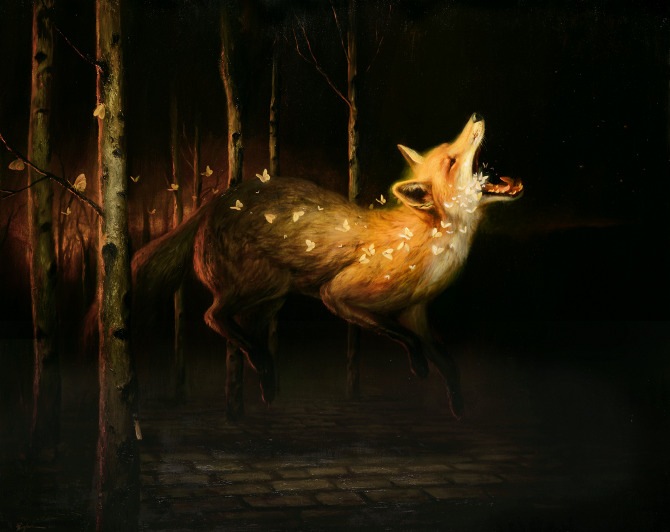empathy
To Beast Or Not To Beast: The Primal Question

Walking into Martin Wittfooth’s cozy Brooklyn studio, I am immediately transported to a world far away from the one we leave on the other side of his door – a large warehouse typical of industrial Bushwick, and the hustle and bustle of the city beyond it. I sense the beginning of a journey, perhaps one not so different from those of the stoic animal protagonists in his vibrant oil paintings. Before he opens the door, Martin turns to me with a shy smile on his face. “I hope you’re not afraid of dogs…” I am greeted by his roommate, Luna, who jumps up and licks my face, then bounds off in front of us, leading the adventure.
A Shaman In His Own Right
Past the loft that houses Martin’s bed, hidden by mismatching wooden shutters, I spy a giant tiger atop a rusting abandoned car, cradling a dead crane. Although one would initially assume that the cat caught the bird, upon closer scrutiny it becomes apparent that some other force is responsible for the outcome of this scene. Roses bloom amid the desolate reeds, and another bird flies off in the hazy distance—both giving a sense of hope and life moving forward in the midst of calamity. But what makes Martin’s latest commission piece, Pieta II, so poignant is the tiger’s simultaneous forbearance and tenderness for his fallen animal friend. About all of his work, Martin explains, “I didn’t want to tell somebody’s story, I want to tell our story.”
Born in Toronto, Martin spent his childhood in Finland, then as a teenager back in Toronto began his artist’s life as an illustrator. Allegory is a crucial aspect of Martin’s visual fables, and the mythology of the Old Country certainly stands out as inspiration. “When you look at Greek mythology or Norse mythology or Eastern mythology or South American, animalistic, shamanistic mythology, all these have very strong visual components and storytelling components that rely heavily on the human imagination to give them volume. And the volume you get is of these epic worlds and crazy stories. So I kind of grew up on those as a kid.”
Earlier in our conversation, Martin mentioned being drawn to representational work. While studying for his master’s degree at the School of Visual Arts (SVA), Martin moved away from illustration and adopted a more classical method of painting. However, that is not to say that Martin’s “self-portraits” are in any way traditional. When asked about the lack of a human self in these portraits, Martin explained, “Often people have looked at my work and thought that it’s all about the plight of the natural world and animal stuff, but oftentimes I’m using my animals as kind of stand-ins for either myself or the human condition in general.”
One doesn’t have to go far to find a real live example of such a work of reflection. Martin’s most recent exhibition piece, Smoking Barrels, is on display at the Rick Wester Fine Art (RWFA) gallery in Chelsea at the current “They Are Us: Animal Identity and the Anthropomorphic Urge,” exhibition. Among the photographs and animal statues, Martin’s depiction of the western black rhinoceros dominates the far wall of the gallery. “The work that I’m most interested in as a viewer, whenever I go anywhere,” Martin tells me, “is the work that has tension in it.” Smoking Barrels contains acute yet tasteful tension in its melding of a natural animal with symbolic references to a destructive human industry. According to Martin, the black rhinoceros, stuffed models of which he photographed for reference at the American Museum of Natural History, coincidentally went extinct the day before he started working on a commission using this particular species. Martin is now conceptualizing a series that will focus on other species that are extinct or endangered, and make allusions to what is taking them out.
While Martin does “not shy away from getting kind of violent” in many of his paintings, he made it clear that he is firmly against simply documenting some sort of apocalypse. The flora that has a large presence in many of his portraits gives the viewer a sense of rebirth amidst their destructive landscapes. More recently, Martin has been heavily influenced by ancient ideas of shamanistic practices and psychedelics as tools for a reawakening. “What I think really matters are the things that unite us both with nature and at the same time unite us as one species.” His recent Nocturne series portrays animals communicating with a tangible, natural language of birds or butterflies coming out of their mouths. Other paintings also depict animals with spirit-like secretions bursting from their mouths, channeling the divine, and representative of shamanic incantations.
As our conversation draws to a close, I feel a new sense of hope from my exposure to the world Martin inhabits in both his paintings and everyday life. The reawakening that he refers to verbally, as well as abstractly through his art, attempts to put humans back in touch with nature and essentially themselves. And while he acknowledges candidly that our physical reality at this moment might seem bleak and hopeless, what humans should focus on changing first is the way they look at things. Martin contemplates, “I’m always compelled by this idea of around the corner there can be a beautiful new dawn. It may not be a matter of necessarily setting right what can’t be fixed but just seeing new solutions.”
Martin Wittfooth [Price range of works: 12,000 – 25,000 Dollars]
Article by Sophia Archibald
Be the first to write a comment.
Your feedback






